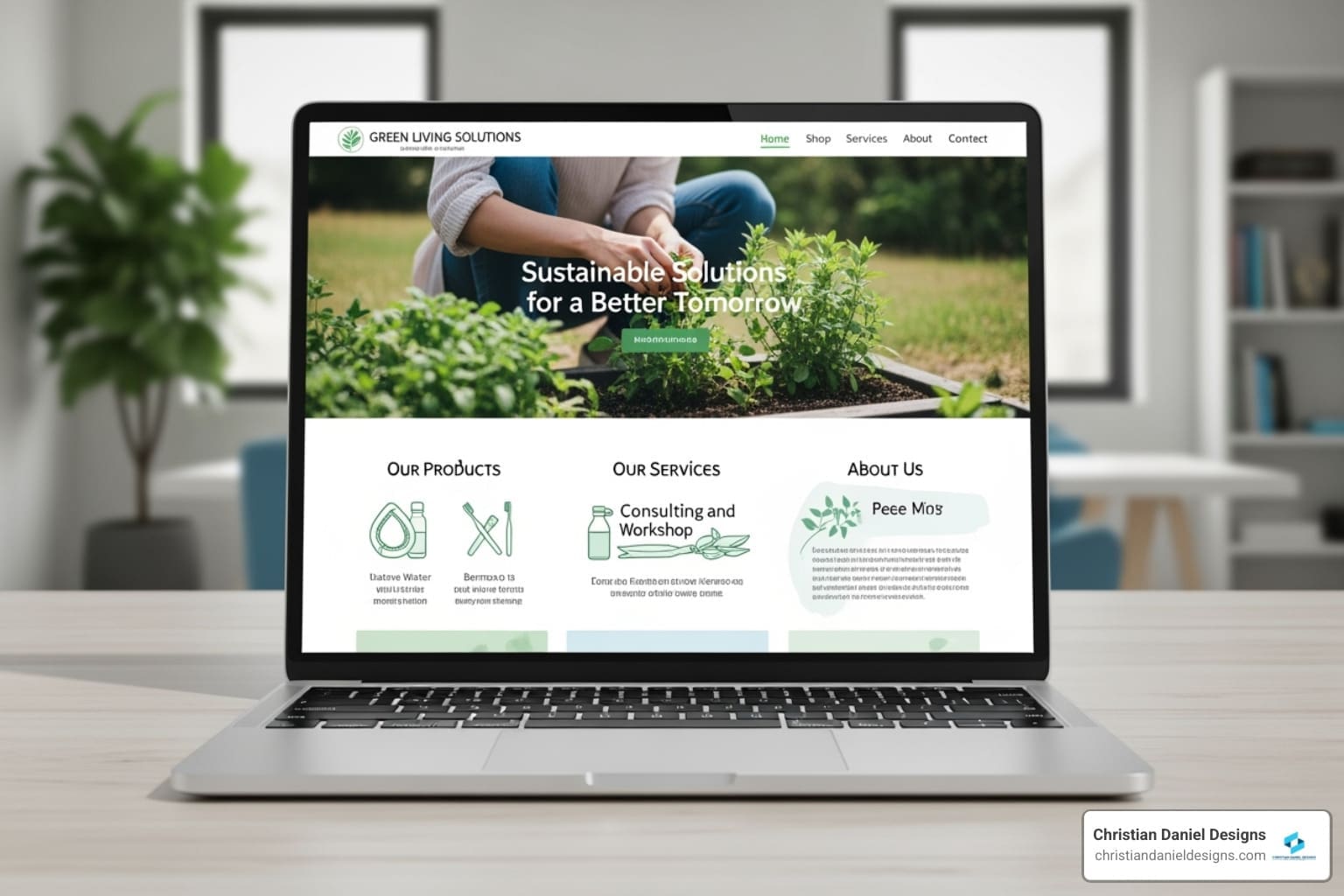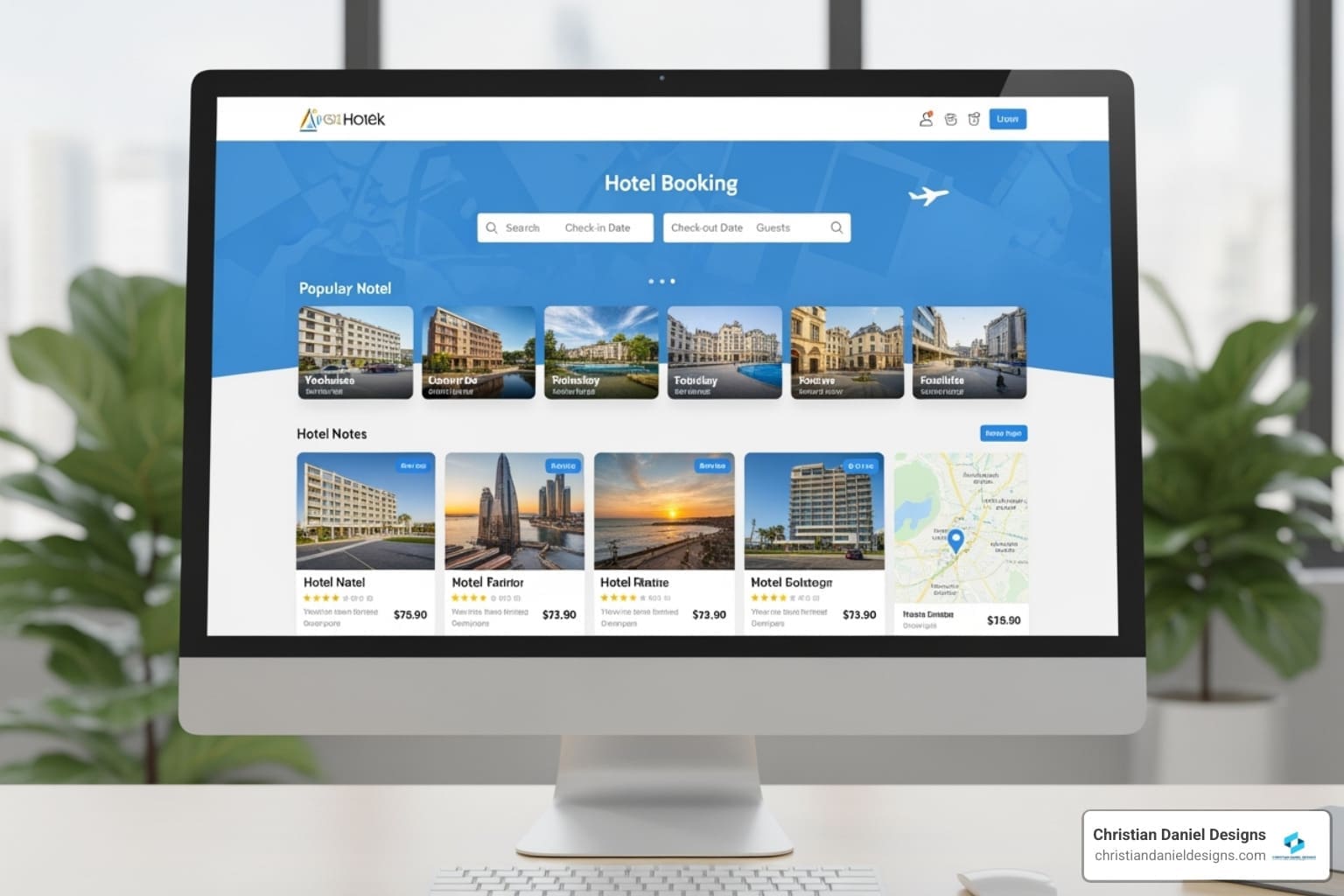Custom E-commerce Solution: Ultimate Guide 2025
Why Your Online Store Deserves More Than a Template
A custom e-commerce solution is an online store built from the ground up to match your specific business needs, brand identity, and growth goals. Unlike template-based platforms like Shopify or Wix that force you into pre-designed boxes, a custom solution offers unlimited flexibility.
Key differences between custom and template solutions:
| Feature | Custom E-commerce Solution | Template Platform |
|---|---|---|
| Design | Unique, brand-specific | Shared with thousands of sites |
| Functionality | Built for your exact needs | Limited to available plugins |
| Scalability | Grows seamlessly with your business | Often hits walls as you expand |
| Ownership | You own all code and assets | Platform controls everything |
| Long-term cost | No recurring platform fees | Monthly fees that increase with growth |
Many business owners start with templates for their speed and affordability but soon find the hidden costs: transaction fees, expensive app subscriptions, and design constraints that prevent them from standing out. With global retail e-commerce sales set to surpass $8 billion by 2025, fierce competition means generic storefronts are no longer enough.
Businesses that switch to custom solutions often see 63% higher engagement and significant revenue increases. Custom sites also load approximately 50% faster, directly improving user experience and search rankings.
I’m Christian Daniel, founder of Christian Daniel Designs. With over 20 years of experience building custom websites for businesses across the United States, I’ve seen how a properly designed custom e-commerce solution transforms struggling online stores into conversion powerhouses.

Custom e-commerce solution vocabulary:
Why a Custom E-commerce Solution is the Right Choice
After two decades of building websites, I’ve learned that your e-commerce platform is a strategic decision that shapes your business’s future.

I often speak with business owners frustrated by template platforms. They start with Shopify or Wix for the low upfront cost, but soon face limitations. Adding a new feature requires an expensive app, their site looks like their competitors’, and they’re paying transaction fees on top of monthly subscriptions. The Total Cost of Ownership (TCO) quickly rises, making the “affordable” platform anything but.
A custom e-commerce solution gives you complete control. You aren’t forced into someone else’s vision; every pixel and feature is designed for your business and your customers.
| Feature | Custom E-commerce Solution | Template Platform |
|---|---|---|
| Flexibility | Unlimited customization, unique features | Limited to platform’s built-in options & app store |
| Scalability | Built to handle massive growth & traffic | Can hit performance ceilings, costly upgrades |
| Cost | Higher upfront investment, lower long-term TCO | Lower upfront, higher TCO due to fees & add-ons |
| Maintenance | Dedicated support, custom updates | Platform-driven, sometimes forces unwanted changes |
Think of it like this: you can buy a pre-fab house, or you can work with an architect to design a home that fits your life perfectly. Only one will truly feel like yours.
Core Benefits of a Custom E-commerce Solution
When I build a custom e-commerce solution, I start with a blank canvas. This approach delivers benefits that templates can’t match.
- Complete Flexibility: If you can imagine it, I can build it. Whether it’s a custom product configurator or a unique checkout flow, your website should address your specific business needs directly.
- Unique Brand Identity: Your brand deserves more than a theme used by thousands of other stores. I create designs that reflect your unique personality, turning first-time visitors into loyal customers.
- Built-in Scalability: As your product catalog and traffic grow, your custom site handles it smoothly. You avoid the nightmare of outgrowing your platform and needing a costly migration.
- Full Code Ownership: When I build your site with open-source technologies, you own everything. There are no recurring platform fees, and you have the freedom to modify and evolve your site whenever you need to.
This all adds up to a genuine competitive advantage. For more details on my approach, check out my custom website design services.
The Hidden Costs and Limitations of Template Platforms
The advertised price of template platforms is misleading. That low monthly plan quickly balloons once your business is running.
- Transaction Fees: Many platforms charge a percentage of every sale (e.g., 2%) unless you use their payment system. On $100,000 in sales, that’s an extra $2,000 per year.
- App Subscription Costs: Need better email marketing or advanced shipping? Those features often require apps costing $15-30/month each, quickly adding up to over $100 monthly.
- Design Constraints: You can change colors and fonts, but you can’t fundamentally reshape the user experience. Your store ends up looking generic, not perfect.
- Limited Functionality: Specific needs like B2B tiered pricing, product configurators, or complex subscription models are often impossible or require clunky workarounds.
- SEO Limitations: You’re optimizing within someone else’s framework, which controls your site structure, URLs, and page speed. A custom solution lets me build SEO into the architecture for a true competitive edge.
- Platform Dependence: When the platform changes its fee structure or removes a feature, you have no choice but to accept it. You’re building your business on rented land.
I cover these challenges in my Designing a Small Business Website Guide.
My Custom E-commerce Development Process
Building a custom e-commerce solution is a careful journey where every decision matters. I’ve refined this process over two decades to turn your vision into a high-performing online store.

My process begins with deep research into your business, customers, and competitors. I then move to strategy and UX design, creating the blueprint for your site through sitemaps and wireframes. This is followed by development, rigorous testing, and finally, launch and ongoing support. Every project is different, but these core phases ensure success.
Phase 1: Strategy and User Experience (UX) Design
Before any code is written, I need to understand what makes your business tick. Through close client collaboration, I work with you to define your business goals, whether it’s increasing sales or streamlining operations. Next, I conduct target audience analysis to understand your customers’ behaviors and pain points.
With that foundation, I create user journey maps to design a smooth path to purchase. I then build a sitemap to organize your content logically for both users and search engines. This is followed by wireframing key pages—architectural blueprints focusing on functionality and layout. For critical flows, I create interactive prototypes so you can experience how the site will work, catching potential issues early. This phase is about creating a solid foundation for a Conversion-Focused Web Design that performs.
Phase 2: Custom UI Design and Development
With the strategy locked in, I bring your custom e-commerce solution to life. I start with brand-centric design concepts, creating high-fidelity mockups that capture your brand’s personality. For front-end development, I use modern technologies like React to build fast, responsive, and app-like user interfaces.
The back-end development is the site’s engine, handling everything from products and orders to customer accounts. I often use robust frameworks like Laravel to keep the code clean and scalable. The database is structured for speed and growth. A key advantage of a custom build is unlimited API integrations, allowing me to connect your store to any CRM, ERP, or other systems you use. For inspiration, see my guide on Payment Gateway Integration. My experience with Online Shop Web Design ensures every element serves a purpose.
Phase 3: Testing, Launch, and Maintenance
Building the site is only half the battle. Performance optimization is non-negotiable; I obsess over load times because a slow site kills conversions. Custom code typically loads about 50% faster than templates, and I optimize every element for maximum speed. I run exhaustive cross-browser testing and mobile responsiveness checks to ensure your site works flawlessly on any device.
Security audits are critical for protecting customer data and ensuring PCI DSS compliance. After squashing any bug fixes, your site goes live. I provide post-launch support to address any immediate issues. Websites aren’t “set it and forget it,” so my maintenance plans cover security updates, performance monitoring, backups, and technical support to prevent problems down the road. My guide on Web Design for Business Owners offers more insights on this.
Understanding the Investment: Cost, ROI, and Key Integrations
Investing in a custom e-commerce solution is a big leap, so I want to cover the cost and whether it’s worth it. Think of this as an investment in your business’s future, not just a purchase.

Using the Canadian market as a benchmark, most custom e-commerce solutions fall between $10,000 and $100,000. This wide range exists because every business has different needs and levels of complexity.
Breaking Down the Costs
Several factors determine your investment:
- Design Complexity: A basic site might be $5,000–$20,000. Most clients need a mid-level site with custom UI/UX and SEO, which typically lands in the $20,000–$50,000 range. Advanced solutions with unique features or AI can be $50,000–$100,000+.
- Custom Functionality: Features like a product configurator, loyalty program, or complex filtering add development time but set you apart from competitors.
- Third-Party Integrations: Connecting your store to an ERP, CRM, or POS system is critical for efficiency. These integrations can cost $5,000–$50,000 each, depending on complexity. Proper Payment Gateway Integration is essential from the start.
- Data Migration & Hosting: Transferring product and customer data from another platform requires careful execution. You’ll also need solid hosting, which can run $500–$5,000 annually.
- Ongoing Support Fees: Your site needs regular maintenance, including security updates, performance optimization, and technical support. This typically runs $1,000–$15,000 annually for small to medium businesses.
Calculating the ROI on Your Custom E-commerce Solution
A custom e-commerce solution costs more upfront, but the returns are substantial and compound over time.
- Increased Conversion Rates: A site built for your customers—with intuitive navigation and a streamlined checkout—turns more visitors into buyers. For example, offering a guest checkout can prevent the 28% of shoppers who abandon carts when forced to create an account.
- Higher Average Order Value (AOV): Smart product recommendations and strategic upsells designed for your catalog increase the amount customers spend per transaction.
- Improved Customer Lifetime Value (CLV): A superior experience builds loyalty, encouraging repeat purchases.
- Reduced Operational Costs: Automating data flow between your e-commerce site and other business systems (ERP, CRM) eliminates hours of manual work and reduces errors.
- Long-Term Scalability Savings: Building for growth from day one means you won’t need a costly re-platforming project in a few years. Forrester found that businesses with customized platforms can see a 211% ROI by the third year.
My Custom Website Small Business Guide walks through these considerations in more detail.
Future-Proofing Your Business for Long-Term Growth
A custom e-commerce solution is about building a foundation that grows with your business for years to come. I design with the future in mind, considering how your business will evolve and how emerging technologies like headless commerce can fit into your strategy. This is the power of custom development—building scalability, performance, and security into the code from day one.
Adapting to Different E-commerce Business Models
A custom solution can perfectly align with your specific business model, as a one-size-fits-all approach rarely works.
- B2C (Business-to-Consumer): The focus is on a user-friendly UI, mobile optimization, and a frictionless checkout. A custom B2C site typically runs $20,000–$100,000.
- B2B (Business-to-Business): Buyers need features like tiered pricing, bulk ordering, and detailed price lists. Integration with ERP and CRM systems is crucial. A custom B2B solution usually ranges from $50,000–$100,000+.
- C2C (Consumer-to-Consumer): A marketplace requires user profiles, listing management, secure escrow payments, and dispute resolution. These complex platforms typically cost $30,000–$150,000.
- C2B (Consumer-to-Business): This model needs features like bidding systems and freelancer dashboards, which are straightforward to implement in a custom build, usually ranging from $40,000–$100,000.
For service-based businesses, a Custom Booking Engine can be seamlessly integrated to handle both product sales and reservations.
The Role of UI/UX, SEO, and Integrations in Success
Three pillars make or break e-commerce success: UI/UX, SEO, and integrations. A custom e-commerce solution lets me optimize each one for your needs.
- UI/UX directly impacts your bottom line. Every design decision affects conversions. A streamlined checkout that doesn’t force account creation can prevent the 28% of shoppers who abandon their carts. Clear calls to action and intuitive navigation are essential revenue drivers.
- SEO is built into the foundation. I structure your site with search engines in mind from the start. This means clean URLs, fast site speed (custom code is about 50% faster), and structured data for rich search results. Better organic rankings mean less reliance on paid ads.
- Integrations create a central business hub. I can connect your store to marketing automation platforms, inventory management systems, and shipping carriers. This streamlines operations, prevents overselling, and creates a seamless customer experience.
This holistic approach is what separates a functional site from one that drives growth. For more insights, check out my Web Design Small Business Guide 2025.
Essential Features for a Scalable E-commerce Site:
- Customizable product pages
- Robust search and filtering
- Secure, streamlined checkout
- Integrated payment gateways
- Flexible shipping options
- Customer accounts and order history
- Inventory management system
- CRM and marketing integration
- Analytics and reporting dashboard
- Blog or content management system
- API access for future integrations
- Advanced security (PCI compliance, SSL)
- Multi-language/currency support
- Mobile responsiveness
Frequently Asked Questions about Custom E-commerce
Which platform is best for a custom e-commerce website?
There is no single “best” platform; it depends entirely on your business needs, budget, and long-term goals. For ultimate flexibility and true ownership, I recommend a custom e-commerce solution built around your business model. I often use open-source technologies because they offer freedom from the recurring fees, policy changes, and limitations of proprietary platforms like Shopify.
With a custom build, you own the code and control the roadmap. You’re not trapped by a platform that can’t keep up with your growth. My expertise is in crafting solutions that empower your business rather than restrict it.
How long does it take to build a custom e-commerce site?
The timeline varies with complexity, but here are some realistic expectations:
- A simple custom store with a unique design and standard features typically takes 2-4 months.
- A mid-level e-commerce site with custom functionalities and integrations usually takes 4-6 months. Even enterprise projects on pre-built platforms often take this long.
- A complex, enterprise-level solution with extensive API integrations or a unique business model could take 6 months or more.
Rushing development leads to bugs and poor performance. My goal is to deliver a site that works flawlessly from day one and serves your business for years.
What are the ongoing costs after the website is launched?
A custom e-commerce solution avoids recurring platform fees, but there are essential ongoing costs to maintain your investment.
- Web Hosting: This can range from $500–$5,000 annually, depending on your traffic and performance needs.
- Domain & SSL: Your domain renewal is typically $15-$100 annually, and an SSL certificate for security can be $50–$1,500 yearly (though often included with hosting).
- Third-Party Subscriptions: You may still use specialized tools for email marketing or analytics that have their own fees.
- Monthly Maintenance Plan: This is the most important ongoing investment. It covers security updates, bug fixes, performance monitoring, backups, and technical support. These plans typically range from $1,000–$15,000 annually for most businesses, while enterprise-level support can be $5,000–$50,000+ annually.
Budgeting for these costs from the start is essential to keep your e-commerce site secure, fast, and driving revenue.
Conclusion
The digital marketplace is crowded, and a cookie-cutter storefront isn’t enough to stand out. A custom e-commerce solution is a strategic investment in your business’s future, delivering unparalleled flexibility, scalability, and a unique brand experience that template platforms can’t match.
As I’ve shown, custom development helps you avoid the hidden costs and limitations of templates. You gain complete control, build a true digital asset, and create a store designed to grow with you. The results are clear: custom sites load 50% faster, and businesses often see 63% higher engagement and a significant ROI.
As an NYC web designer with over 20 years of experience, I’ve witnessed how the right custom e-commerce solution transforms businesses. I’ve guided dozens of clients through this journey, creating sites that work as hard as they do.
Your business deserves more than a template. If you’re ready to stop fighting with restrictive platforms and build something truly yours, I’m here to help. Contact me to discuss your custom website design, and I will craft an e-commerce solution that exceeds your expectations.











